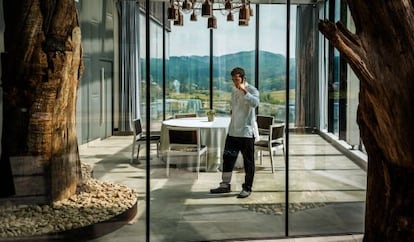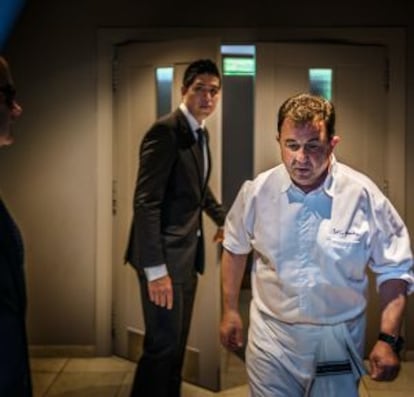The power of Basque cuisine
What drives the culinary excellence of a region that is home to five of the world¡¯s best restaurants?

On the day that Juan Mari Arzak¡¯s father died, 60 people came to eat in his family¡¯s tavern outside San Sebasti¨¢n. They made fish soup, bean stew, and hake in green sauce. They killed chickens and they uncorked cider bottles. His widowed mother Paquita Arratibel, who had worked as a cook for a Madrid family before marrying Juan Ram¨®n Arzak, did not move from the kitchen on that day, either. It was the metaphor of her life.
That was back in 1951, when Juan Mari Arzak was nine years old. Now 72, the man who is hailed as the pioneer of New Basque Cuisine, the movement that put the northern region on the international culinary map, still remembers that day. And he admits that everything around here revolves around food.
It was inside that unpretentious roadside restaurant, which survived on wedding and baptism banquets, that the first tentative steps of New Basque Cuisine were taken in the mid-1970s. By 1989, Arzak became the first restaurant in Spain to earn three Michelin stars. It also ranks eighth on Restaurant magazine¡¯s World¡¯s 50 Best list.
The figures say it all: of the eight restaurants in Spain with three Michelin stars, half are in the Basque Country: three in Gipuzkoa province (Arzak, Mart¨ªn Berasategui and Akelarre) and one in Bizkaia (Azurmendi). By comparison there are two in Catalonia (Sant Pau and El Celler de Can Roca), one in Madrid (DiverXo), and one in Valencia (Quique Dacosta).
Young chefs are flocking to the Basque Country, working as kitchen assistants in a bid to learn from the masters
From an international perspective, five of the world¡¯s 50 best restaurants can be found in the Basque Country. That is as many as in the whole of France, the home of haute cuisine.
And within the Basque Country, the city of San Sebasti¨¢n (population 300,000) and its outlying areas have no fewer than 16 Michelin stars.
No other area on the planet can boast such a density of Michelin stars. How did this land of shepherds, traders and smallholders that suffered four decades of ETA terrorism manage to rise to the top of global gastronomy?
The recipe for success cannot easily be replicated, even though there are those who are trying: Scandinavian countries, Peru and Singapore are all attempting to develop a new high-level cuisine of their own to attract quality tourism. It is a bit like trying to replicate the effect the arrival of the Guggenheim Museum had on the Basque city of Bilbao. Many try, but few succeed.

There are many other Basque names besides Arzak at the helm of prestigious kitchens: Berasategui, Subijana, Argui?ano, Arbelaitz, Aduriz, Oihaneder, Atxa, Arginzoniz, Aguirre ... they represent the highest level of gastronomy, often offered at accessible prices in the form of pintxos (Basque tapas) on display on bar counters across the region, and most famously in San Sebasti¨¢n¡¯s old quarter, the Parte Vieja.
They all share similar commandments: a preference for local and seasonal produce, technical know-how, imagination, and a balance between the traditional and the avant-garde. And above all, respect for the legacy they received from their forebears. Mart¨ªn Berasategui, who can lay claim to seven Michelin stars between his restaurants in Lasarte, Barcelona and Tenerife, is also the owner of Bodeg¨®n Alejandro, a modest eaterie in San Sebasti¨¢n where his mother and aunt cooked for decades. That was his elementary school.
The Arzaks are also continuing a family tradition: Juan Mari¡¯s daughter Elena is also considered one of the best chefs in the world by critics. Both continue to work five days a week, tasting every dish that comes out of their kitchen and greeting diners in the same place where other generations of Arzaks began the business in 1897.
Arzak¡¯s regular clientele are not, as you might think, the affluent, but rather the local middle classes. Some people save for months to be able to afford a celebratory meal at a cost of around €200 a head, which is still a fraction of what a three-Michelin-star restaurant might cost in New York, Paris or Tokyo. ¡°We get a lot more middle-class people than the rich folks,¡± says Arzak. ¡°It may come as a surprise to many, but this is still a simple, family-run business. Our philosophy is to make people happy, to make them feel at home. We Basque chefs have the cheapest haute cuisine establishments in the world.¡±
The 1970s movement was a spontaneous initiative by a dozen or so chefs who had no particular strategy in mind
Many chefs interviewed for this article used the word ¡°evolution¡± to define their model. Essentially, they took the dishes that were being prepared a century ago, reinvented them over the course of 40 years, and produced a new menu that has turned them into celebrities, contributing powerfully to the Basque Country brand.
¡°Compared to the Scandinavians, who are all the rage now thanks to Noma in Copenhagen [crowned Best Restaurant in 2014], but lack a culinary tradition and a great product, we Basque chefs had the initial advantage of a powerful popular cuisine,¡± says Arzak. ¡°What we did was to think about how best to develop it and make it better, healthier, lighter, how to showcase the flavors and do as little damage to the product as possible, and how to give it a personal, auteur touch. Our gastronomic concept was new, but it was firmly anchored in our grandmothers¡¯ cooking and the sociedades gastron¨®micas [male-only social and cooking clubs].¡±
The 1970s movement, he explains, was a spontaneous initiative by a dozen or so chefs who had no particular strategy in mind. ¡°There were few resources, but a great desire to get things done. Nobody gave us a penny, we had no public support. We spent our money on trips to France to see what this nouvelle cuisine business was all about. And we were humble enough to stay there and learn from those who knew the most, the French. And later we shared that with the people back here.¡±
Andoni Aduriz, the owner of Mugaritz and pupil of Ferran Adri¨¤, the Catalan superstar chef, explains it thus: ¡°Along this path of evolution, the first thing we ran into was the primary sector, that is to say producers, and we began working with them ¨C artisan cheesemakers, wineries, farmers. We knew we couldn¡¯t get anywhere without them, and in fact one of our handicaps is a shortage of great products as a result of the exodus from the countryside to the cities. Later we got the secondary sector involved, meaning the food industry. Then came the world of research, innovation, universities, and finally culture. That is why this is a movement, because we are all involved in it.¡±

It is impossible to understand the Basques without understanding their passion for cooking. Theirs is a curious combination of unyielding tradition and innovative spirit ¨C the same combination that led a small, isolated, craggy territory with no big farming or ranching estates to become a major industrial hub in the late 19th century.
These days, if the Guggenheim Museum in Bilbao and the San Sebasti¨¢n International Film Festival represent the two main attractions in the Basque Country, regional cuisine would have to rank third. Haute cuisine has been to the hospitality industry what haute couture was to fashion or Formula 1 to the automobile industry: a symbol, a testing ground and a center of media attention. This region of two million inhabitants gets four million visitors a year, and many of them are big spenders ¡ª especially the Americans, who spend an average €1,500 per capita, twice that of other tourists.
This French connection goes back to the Belle ¨¦poque, when Europe¡¯s aristocracy used to spend its summers in the French and Spanish Basque Country. Grand hotels were built in San Sebasti¨¢n to house these noble visitors, including the Mar¨ªa Cristina, the Londres and the Continental. It was also at the turn of the 20th century that the first international restaurants emerged, and they used French produce to make up for the food shortages in poverty-ridden Spain.
Those wealthy families also used to bring their French and English cooks along to San Sebasti¨¢n, Getaria and Zarautz, people who were often hired straight out of the Hilton in London or the Ritz in Paris, and created teams of assistants using local farm girls already familiar with traditional Basque cuisine.
One of those young farm girls, Nicolasa Pradera, would go on to open San Sebasti¨¢n¡¯s first great restaurant in 1912, Casa Nicolasa, which represented a fusion of Basque farmer¡¯s food and French sophistication. These generations also produced the forebear of today¡¯s New Basque Cuisine, Luis Ir¨ªzar, who taught Pedro Subijana and Karlos Argui?ano after studying in Britain, France and Switzerland.
Our philosophy is to make people feel at home. We Basque chefs have the cheapest haute cuisine establishments in the world¡± Chef Juan Mari Arzak
These days, young chefs are flocking to the Basque Country instead, working as kitchen assistants in a bid to learn from the masters and take this knowledge to other parts of the planet. Hundreds of them have interned at restaurants in the province of Gipuzkoa this year alone, many at the orders of Mart¨ªn Berasategui, a specialist in creating teams that he later sends to his own restaurants.
Yet not all the best chefs get this kind of sophisticated training. The man who has revolutionized Basque grilled food lives in a hamlet of 300 people in the achingly beautiful valley of Atxondo. He has no family background in restaurant work, and he worked for a pulp and paper company before deciding to open a carvery 25 years ago.
It was initially going to be a run-of-the-mill grilled fish establishment, but Bittor Arginzoniz, 54, turned tradition around, reinventing all the tools of the trade. The first thing he did was to reject coal ¡°because it added excessively aggressive aromas to the products.¡±
His restaurant, Etxebarri, has one Michelin star and ranks 34th among the world¡¯s best. To watch this solitary, laconic, deeply concentrated figure cook at 50?C temperatures with hardly anyone to help him is to feel part of an initiation rite, and reminds one of Japan¡¯s no-frills cuisine.
Early every morning, he gets two fires started using different types of wood: holly oak, English oak and vine shoots (sarmiento). Later he distributes it under specially designed grills that hang at various levels using pulleys. Arginzoniz, who grows his own vegetables and keeps chickens and cows for eggs and milk, grills baby eels, oysters, croquettes, kokotxas (hake and cod cheeks), octopus and risotto.
And he continues to experiment. He admits that as a child his passion was to dominate fire, the most primeval element of all. And he has managed it. Just like Basque cuisine in the last 40 years, he has evolved, too. He has brought fire up to date. It is impossible to go further than that.
Tu suscripci¨®n se est¨¢ usando en otro dispositivo
?Quieres a?adir otro usuario a tu suscripci¨®n?
Si contin¨²as leyendo en este dispositivo, no se podr¨¢ leer en el otro.
FlechaTu suscripci¨®n se est¨¢ usando en otro dispositivo y solo puedes acceder a EL PA?S desde un dispositivo a la vez.
Si quieres compartir tu cuenta, cambia tu suscripci¨®n a la modalidad Premium, as¨ª podr¨¢s a?adir otro usuario. Cada uno acceder¨¢ con su propia cuenta de email, lo que os permitir¨¢ personalizar vuestra experiencia en EL PA?S.
?Tienes una suscripci¨®n de empresa? Accede aqu¨ª para contratar m¨¢s cuentas.
En el caso de no saber qui¨¦n est¨¢ usando tu cuenta, te recomendamos cambiar tu contrase?a aqu¨ª.
Si decides continuar compartiendo tu cuenta, este mensaje se mostrar¨¢ en tu dispositivo y en el de la otra persona que est¨¢ usando tu cuenta de forma indefinida, afectando a tu experiencia de lectura. Puedes consultar aqu¨ª los t¨¦rminos y condiciones de la suscripci¨®n digital.









































